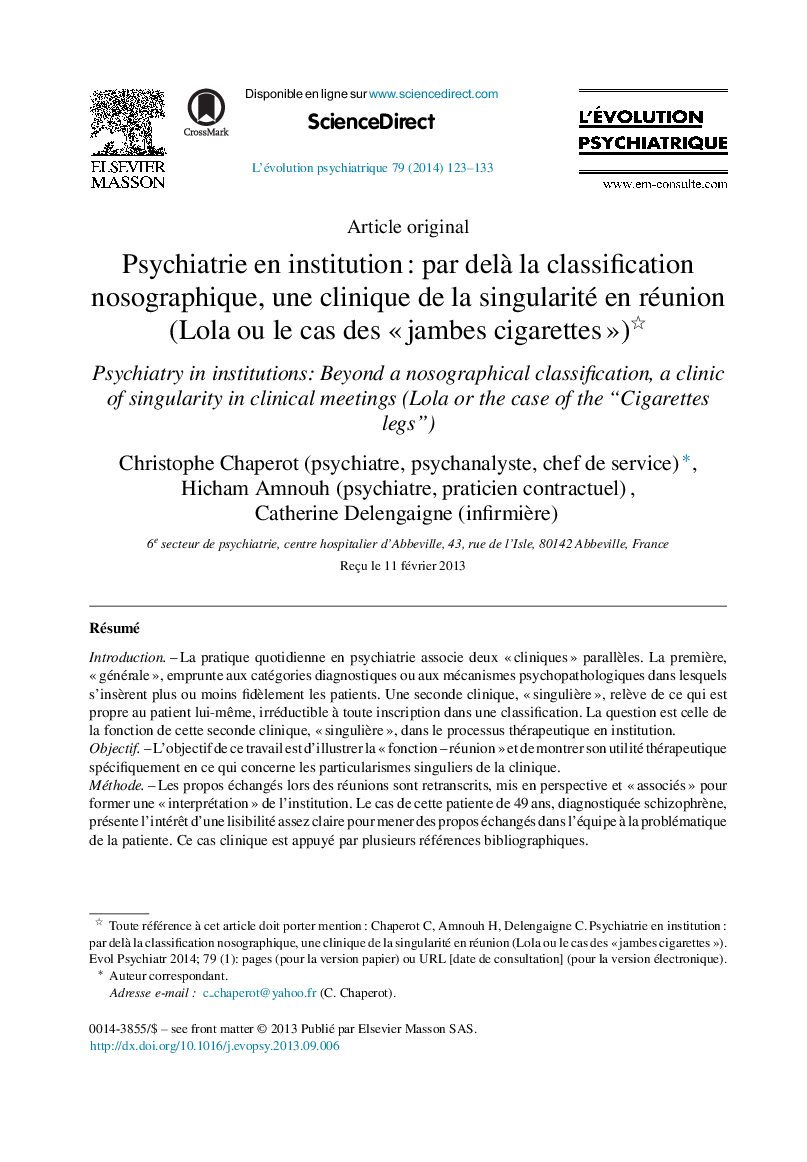| کد مقاله | کد نشریه | سال انتشار | مقاله انگلیسی | نسخه تمام متن |
|---|---|---|---|---|
| 908664 | 917190 | 2014 | 11 صفحه PDF | دانلود رایگان |

RésuméIntroductionLa pratique quotidienne en psychiatrie associe deux « cliniques » parallèles. La première, « générale », emprunte aux catégories diagnostiques ou aux mécanismes psychopathologiques dans lesquels s’insèrent plus ou moins fidèlement les patients. Une seconde clinique, « singulière », relève de ce qui est propre au patient lui-même, irréductible à toute inscription dans une classification. La question est celle de la fonction de cette seconde clinique, « singulière », dans le processus thérapeutique en institution.ObjectifL’objectif de ce travail est d’illustrer la « fonction – réunion » et de montrer son utilité thérapeutique spécifiquement en ce qui concerne les particularismes singuliers de la clinique.MéthodeLes propos échangés lors des réunions sont retranscrits, mis en perspective et « associés » pour former une « interprétation » de l’institution. Le cas de cette patiente de 49 ans, diagnostiquée schizophrène, présente l’intérêt d’une lisibilité assez claire pour mener des propos échangés dans l’équipe à la problématique de la patiente. Ce cas clinique est appuyé par plusieurs références bibliographiques.RésultatsLes éléments convergent vers une problématique de deuil avec identification intracorporelle de la mère défunte de la patiente. La réunion clinique de la constellation soignante a rendu possible l’interprétation en plusieurs phases permettant d’observer une nette amélioration clinique de la patiente.DiscussionLe transfert psychotique est « dissocié », « multi-référentiel » et s’éparpille dans l’institution. La « réunion » des soignants entre eux a la fonction de rassembler les fragments transférentiels qui portent sur des qualités singulières. Ce cas clinique permet d’illustrer le déploiement de ce transfert dissocié au sein de l’institution et le rôle de la réunion dans l’« élaboration-interprétation » collective puis la restitution au patient de ce matériel « élaboré-interprété » avec des effets thérapeutiques positifs.ConclusionLa clinique du singulier articulée à celle du général présente un intérêt indéniable. La « fonction réunion » et la « transversalité » ouverte des échanges en équipes au sujet de « détails » particuliers de la manière d’être des patients, peuvent avoir un effet révélateur et secondairement interprétatif favorable dans le cadre de la « psychothérapie institutionnelle ». Cette notion est connue mais souvent abstraite, elle est ici illustrée par un « cas concret ».
IntroductionThe daily psychiatric practice combines two parallel “clinics”. The first, which is called “general”, uses the diagnostic categories or the psychopathological mechanisms usually adopted for the patients. The second, called “singular”, notes that which is specific to the patient him/herself, and irreducible of any entry in a classification. The issue concerns the function of this second “singular” clinic in the therapeutic process in institution.ObjectiveThe objective of this work is to illustrate the “function – meeting” and show its therapeutic usefulness, specifically regarding the singular specificities of the clinic.MethodologyThe remarks exchanged at the meetings are retranscribed, put into perspective and combined to form an “interpretation” of the institution. The case of this 49-year-old woman, diagnosed schizophrenic, has the advantage of a fairly clear readability in stimulating remarks exchanged within the team regarding the problem of the patient. This case is supported by several bibliographical references.ResultsThe elements converge on the problematic of mourning with an intracorporeal identification of the deceased mother of the patient. A clinical meeting of the constellation of nursing staff made the interpretation in several phases possible, allowing the observation of a significant clinical improvement of the patient.DiscussionIn multiple references, psychotic transference is “dissociated” and dispersed in the institution. The function of the meeting of the nursing staff is to collect the transference fragments that have specific qualities. This clinical case illustrates the deployment of this dissociated transference in the institution and the role of the meeting in the collective “elaboration-interpretation” and then the return of this “elaborated-interpreted” material to the patient with positive therapeutic effects.ConclusionSingular, combined with general, clinics are of undeniable interest. The “function – meeting”, the open “transversality” of the exchanges among the teams regarding particular details of the behavior of the patients can have an enlightening, and secondarily a favorable interpretative effect with regards to “institutional psychotherapy”. This concept is well known but often abstract, and this case is a concrete illustration.
Journal: L'Évolution Psychiatrique - Volume 79, Issue 1, January–March 2014, Pages 123–133